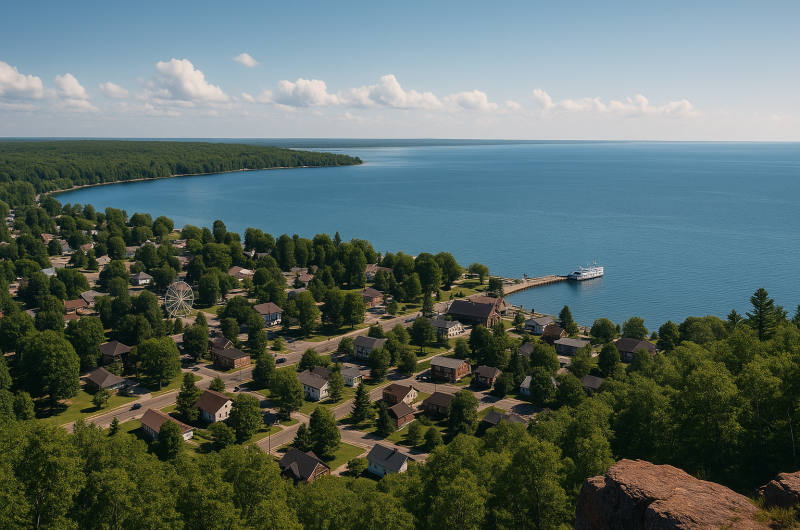Recent UP Migration Trends and Their Economic Consequences

Last month, NOAA’s National Centers for Environmental Information issued a report noting that the US has been hit with a record 23 separate billion-dollar weather-related disasters in 2023, with most of the damage occurring in the South and West. And while the effects of climate change are well documented, there is little evidence that it is influencing Americans’ migration decisions. Indeed, a 2023 Pew Survey found that climate change was less of a concern for Americans than the economy and health care.
Sunbelt states remain the preferred migration destination for millions, despite the region being the most vulnerable to the effects of climate change. Texas and Arizona are experiencing record setting drought and heatwaves, yet their metropolitan areas are among the fastest growing in the nation. A similar pattern is evident in Florida and the Carolinas, with their increased risks arising from flooding associated with tropical storms and advancing sea levels. Sunbelt states attract migrants in part because they are cheaper to live in, with lower taxes and housing costs, than many parts of the Northeast and Midwest.
For those concerned about climate change, moving to the Upper Midwest offers migrants the opportunity to avoid some of its worst effects. In a previous article, we reported on how Marquette County experienced a net gain from migrants moving from Sunbelt states in 2020-21. We suggested that this finding provides tentative support for the idea that the UP might become a climate haven as people leave more vulnerable places in the South and West for places that have (so far) evaded the worst extremes associated with climate change.
This article considers whether other UP counties have experienced a similar gain in net migration, and examines the economic implications of any changes in flows. This study uses IRS change of address data; it is important to note that those who are not required to file Federal income tax returns are not included in the data, which means the poor are underrepresented.
In, Out, and Net Migration
Migration occurs in two forms, in-migration and outmigration, and the difference between the two is net migration. For example, according to the IRS, 12,005 Michigan households moved to Florida in 2020-21 (outmigration), while 7,952 households moved from Florida to Michigan (in-migration), for a net loss of 4,053 households for the state.
For the past several decades, the Upper Peninsula’s population has declined due a falling birth rate, a high death rate due to an aging population, and a net loss from outmigration, as retirees and others have moved away from the region. In 2015-16, for example, IRS data indicate that 5,115 households moved to the UP while 5,906 moved away (Table 1) for a net loss of 791 households, with just three counties experiencing small positive gains (Keweenaw, Luce and Ontonagon).
A more detailed breakdown for the seven largest UP counties shows a net loss in favor of the South and West (Table 2), with a combined outmigration of 1,115 households and only 869 in-migrants. In Marquette County, for example, 196 households left for Western states, while just 108 moved in the opposite direction.
In 2020-21, there was a major change in UP migration patterns (Table 3), with more households moving to the region (7,149) than moving away (6,072). The counties with the largest net household gains were Chippewa (203), Alger (127), Marquette (118), Iron (111), Baraga (110) and Mackinac (100). For six of the seven largest UP counties, there were net gains from Western states (Table 4), and while there was a net positive gain of migrants from the South, it was less than for the West (16 versus 100, respectively). This suggests that moving to the South still retains a positive draw; Mackinac County, for example, experienced a net loss of 28 households to Southern states. Despite the net gains from migration, it does not necessarily translate into population growth since the number of births and deaths must also be counted.
Economic Losses and Gains
The IRS data also enables the calculation of average household income for in and out-migrants. In 2020-21, with just two exceptions (Baraga and Chippewa), the average household income for people moving to the UP was significantly higher than people leaving the region (Table 5). In Houghton and Schoolcraft counties, there was a difference of over $19,000 between in- and out migrants. Keweenaw County is perhaps the most interesting: its 20 newcomer households had an average income of over $106,000, which is well above the county’s median figure of $54,010. The influx of higher income households provides a welcome boost to local economies; however, these newcomers are more likely to be able to afford purchasing or renting a home than many long-term residents with lower incomes. This, in turn, contributes to the well-documented housing affordability issue in the region. In Marquette and Alger Counties, for example, average home values increased 23 percent between 2020-21, pushing home ownership out-of-reach for some. In-migration gains are not unique to the Upper Peninsula. Other rural counties, particularly in so-called amenity areas (with lakes and forests), experienced an influx of population along with a surge in home prices between 2020-21. Newcomers to Flathead County, Montana, (close to Glacier National Park) for example, helped push the population up by nearly 4 percent between 2020-21, while average home values increased by over $200,000 during the same period.
A flash in the pan or the beginning of a long-term trend?
Between 2020-21 the UP experienced a net influx of migrants, with several counties experiencing gains from Sunbelt states. As to whether climate change explains this shift is an open question. 2020-21 was at the beginning of the pandemic and some people may have moved to the area to work remotely, and with the gradual ending of remote work those workers may leave. However, so long as the cost of living in disaster-prone areas remains comparatively low, it seems unlikely that there will be a major climate-related reversal in the UP’s demographic fortunes.












Excellent data.
Interesting statistics. Drummond Island seems to be getting a bump in population since the pandemic with some welcome young entrepreneurs and remote workers.
Those that moved into the UP should be interviewed to see what drew them and how that can be utilized to draw more people to offset the declining population
great content. thanks for creating it
To what extent does the immigration and outmigration of students attending the three UP universities account for the population changes you describe? i.e. does a single university student constitute a “household”? …and… to what extent does a university student’s movements from a location away from the UP to and from a campus during beginnings and endings of semesters each count as one migration event?
Spelling correction: …in-migration and out-migration
Data without explanation is an exercise in frustration. Getting usable data or valid explanations is not easy. The data you can get is NOT the data that you need to understand important trends.
My guess is we’re looking at in and out migration of retirees mostly. Out migration is among long time and older Yoopers who want year round sunshine and warmth (and cheaper taxes than MI) and expect to be gone before climate disruption kicks in viciously.
In migrators are perhaps younger retirees with good retirement incomes getting away from deadly heat, storms and floods. They are happily selling appreciated property and buying bargains in the UP. The size of mid career climigration into the UP is likely small.
All this is speculation until useful information on the size, distribution and quality of the present and projected 20-50 year old work force in the UP is understood. The other out-migration information that’s needed is the loss of high school and college grads and younger work force heading for better job prospects. This type of data is hard to get and usually requires on the ground, face to face collection of information.
The BIG question: How can the UP economy be kick started to create better jobs that promote and support attractive communities. This is enormously difficult.
Invest in higher public education. Consider the case of the Free University of Berlin: After WWII, West Berlin found itself as an isolated enclave completely surrounded by Communist East Germany. The city was in ruins, full of old people. Who would want to live there? The West German government proposed a solution: It created the Free University of Berlin. As an inducement for young people to attend it, and hence, move, to Berlin, the university offered not only free tuition, but all kinds of subsidies, including housing and transportation. In additon, students were exempt from obligatory military service. The result was that young Germans flocked to West Berlin. Eventually young people from all over the world began joining them, including some thousands of young Israelis! Today Berlin is one of the hippest places in the world. Let’s think about doing that to NMU, Michigan Tech, Lake Superior College, and Gogebic Community College. If there is the political will to revive the UP, here is a way. Young people want to live around other young people. With youth comes activity, creativity, energy. A fantasy? “Dream no small dreams for they have no power to move the hearts of men.” [Goethe] [and me]
Hi Bob,
There probably isn’t a way to “kick start” the UP economy, or even the economy of Marquette County. Incremental steps that build our prosperity are likely going to continue to be the way we improve things economically. An interesting contrast between the economies of Michigan and Minnesota, and how young workers have been retained in MN versus drained in MI was recently the subject of a good article in the Michigan Planner, and I think it shows us a way it can be done. What it requires – if we were to follow the MN model – is higher taxation (and good reinvestment use of those revenues collected) and that is not something any politician can sell an increasingly conservative-leaning group of voters in this era. Check it out here: https://michiganfuture.org/2023/11/michigans-path-to-prosperity/
Reply to Davey: you’re right many actions among many actors is the primary method. Often a big goal helps energize other efforts, though.
I live primarily in Minnesota and your comments on MN are correct. The big factor here is we generally believe what Paul Wellstone said: “We’re all better off when we’re all better off”